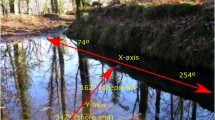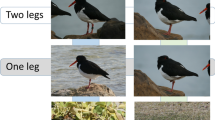Abstract
Sighted African clawed toads use their lateral lines to detect stimulus distance, although accuracy and precision are poorer than for stimulus direction. Single surface wave trains elicited discrete turns and/or swims towards the wave origin. Most responses were brief, ending with the toad stationary (70 % overall; 54–86 % individual toads) or pausing before turning away (11 %; 1–24 %). Lunges or capturing movements with the arms (13 %; 10–22 %) also indicated where toads expected to find prey. Overall, 94 % (88–100 %) of oriented responses had well-defined endpoints. Swim distance—measured as means, medians, and upper and lower quartiles—and the number of bilateral leg kicks increased with stimulus distance. Swim distance also depended upon stimulus angle due to features of turning. Most responses (81 %; 62–92 %) ended short of the wave origin. Regression slopes were 0.45 ± 0.04 mm/mm for stimulus distances up to 85 mm (ca. 2–3x body lengths), 0.16 ± 0.07 mm/mm for distances of 85–130 mm, and non-significant for larger distances to 220 mm. Slopes were steeper for responses that included lunges or capture movements. In only 15 % (3–26 %) of responses were both turn direction and swim distance sufficiently accurate for the toad to sweep through the wave origin.




Similar content being viewed by others
References
Behrend O, Branoner F, Zhivkov Z, Ziehm U (2006) Neural responses to water surface waves in the midbrain of the aquatic predator Xenopus laevis laevis. Eur J Neurosci 23:729–744
Behrend O, Branoner F, Ziehm U, Zhivkov Z (2008) Lateral line units in the amphibian brain could integrate wave curvatures. J Comp Physiol A 194:777–783
Bleckmann H (1980) Reaction time and stimulus frequency in prey localization in the surface-feeding fish Aplocheilus lineatus. J Comp Physiol 140:163–172
Bleckmann H (1988) Prey identification and prey localization in surface-feeding fish and fishing spiders. In: Atema J, Fay RR, Popper AN, Tavolga W (eds) Sensory biology of aquatic animals. Springer, New York, pp 619–641
Bleckmann H, Barth FG (1984) Sensory ecology of a semi-aquatic spider. II. The release of predatory behavior by water surface waves. Behav Ecol Sociobiol 14:303–312
Bleckmann H, Tittel G, Blübaum-Gronau E (1989) The lateral line system of surface-feeding fish: anatomy, physiology, and behaviour. In: Coombs S, Görner P, Münz H (eds) The mechanosensory lateral line: neurobiology and evolution. Springer, New York, pp 501–526
Bleckmann H, Borchardt M, Horn P, Görner P (1994) Stimulus discrimination and wave source localization in fishing spiders (Dolomedes triton and D. okefinokensis). J Comp Physiol A 174:305–316
Branoner F, Zhivkov Z, Ziehm U, Behrend O (2012) Central representation of spatial and temporal surface wave parameters in the African clawed toad. J Comp Physiol A 198:797–815
Brownell P, Farley R (1979) Detection of vibration in sand by tarsal sense organs of the nocturnal scorpion, Paruroctonus mesaensis. J Comp Physiol A 131:23–30
Brudermanns B, Elepfandt A (2004) Excellent discrimination of the distance of two simultaneous water wave sources by the clawed frog Xenopus laevis laevis. In: Abstractband of the 97th congress of the German zoological society, May 31–June 4, University of Rostock, p 100
Buschmann HP (1984) Untersuchungen zur Entfernungslokalisation beim Krallenfrosch Xenopus laevis D. Diplomarbeit, Universität Bielefeld
Buschmann P, Görner P (1990) Distance localization of the center of a surface wave in the clawed toad Xenopus laevis Daudin. In: Elsner N, Roth G (eds) Proceedings of 18th Göttingen neurobiology conference, Thieme, Stuttgart, p 165
Claas B (1993) Wie analysiert das Seitenliniensystem die Laufrichtung von Oberflächenwellen? Habilitationsarbeit, Universität Bielefeld (in German)
Claas B, Dean J (2006) Prey-capture in the African clawed toad (Xenopus laevis): comparison of turning to visual and lateral line stimuli. J Comp Physiol A 192:1021–1036
Claas B, Münz H (1996) Analysis of surface wave direction by the lateral line system of Xenopus: source localization before and after inactivation of different parts of the lateral line. J Comp Physiol A 178:253–268
Claas B, Münz H, Zittlau KE (1989) Direction coding in central parts of the lateral line system. In: Coombs S, Görner P, Münz H (eds) The mechanosensory lateral line: neurobiology and evolution. Springer, New York, pp 409–419
Claas B, Münz H, Görner P (1993) Reaction to surface waves by Xenopus laevis Daudin: are sensory systems other than the lateral line involved? J Comp Physiol A 172:759–765
Elepfandt A (1982) Accuracy of taxis response to water-waves in the clawed toad (Xenopus laevis Daudin) with intact or with lesioned lateral line system. J Comp Physiol 148:345–535
Elepfandt A (1989) Wave analysis by amphibians. In: Coombs S, Görner P, Münz H (eds) The mechanosensory lateral line: neurobiology and evolution. Springer, New York, pp 527–541
Elepfandt A, Wiedemer L (1987) Lateral-line responses to water-surface waves in the clawed toad, Xenopus laevis. J Comp Physiol A 160:667–682
Görner P (1963) Untersuchungen zur Morphologie und Elektrophysiologie des Seitenlinienorgans vom Krallenfrosch (Xenopus laevis, Daudin). Z vergl Physiol 47:316–338
Görner P (1973) The importance of the lateral line system for the perception of surface waves in the claw toad, Xenopus laevis, Daudin. Experientia 29:295–296
Görner P (1976) Source localization with labyrinth and lateral line in the clawed toad (Xenopus laevis). In: Schuijf A, Hawkins AD (eds) Sound reception in fish. Elsevier, Amsterdam, pp 171–184
Görner P, Mohr C (1989) Stimulus localization in Xenopus: role of directional sensitivity of lateral line stitches. In: Coombs S, Görner P, Münz H (eds) The mechanosensory lateral line: neurobiology and evolution. Springer, New York, pp 543–560
Görner P, Moller P, Weber W (1984) Lateral-line input and stimulus localization in the African clawed toad Xenopus sp. J Exper Biol 108:315–328
Gregory RL (1966) Auge und Gehirn: Zur Psychophysiologie des Sehens. Kindler Verlag, München
Hoin-Radovsky I, Bleckmann H, Schwartz E (1984) Determination of source distance in the surface-feeding fish Pantodon bucholzi (Pantodontidae). Anim Behav 32:840–851
Kramer G (1933) Untersuchungen uber die Sinnesleistungen und das Orientierungsverhalten von Xenopus laevis Daud. Zool Jb Physiol 52:629–676
Kroese ABA, Van der Zalm JM, Van den Bercken J (1978) Frequency response of the lateral-line organ of Xenopus laevis. Pflügers Arch 375:167–175
Lighthill MJ, Sir (1978) Waves in fluids. Cambridge University Press, New York
Rudolph P (1967) Zum Ortungsverhalten von Gyrinus substraticus Steph (Taumelkäfer). Z vergl Physiol 50:341–361
Schwartz E (1971) Die Ortung yon Wasserwellen durch Oberflächenfische. Z vergl Physiol 74:64–80
Traub B, Elepfandt A (1990) Sensory neglect in a frog: evidence for early evolution of attentional processes in vertebrates. Brain Res 530:105–107
Zittlau KE, Claas B, Münz H (1986) Directional sensitivity of lateral line units in the clawed toad Xenopus laevis Daudin. J Comp Physiol A 158:469–477
Acknowledgments
Kristin Zhong helped with the data preparation. Volker Duerr (University of Bielefeld) generously provided a Delphi program that was modified for the video frame analysis. Experimental procedures and animal care were reviewed and approved by CSU’s Institutional Animal Care and Use Committee (#2204-DEA-AS).
Author information
Authors and Affiliations
Corresponding author
Electronic supplementary material
Below is the link to the electronic supplementary material.
Figure S1
Mean stimulus distance and swim distance by absolute value of stimulus angle. Means and Bonferroni intervals from general linear regressions with animal and stimulus angle as factors. Student-Neuman-Keuls pair-wise tests show all differences significant at the 5 % level except for the three pairs of values underlined with brackets. Stimulus distance N = 2,754; swim distance N = 1,882, which excludes 116 swims reaching the boundary. (DOC 332 kb)
Rights and permissions
About this article
Cite this article
Dean, J., Claas, B. African clawed toads (Xenopus laevis) sense the distance of lateral line stimuli. J Comp Physiol A 200, 657–667 (2014). https://doi.org/10.1007/s00359-014-0911-5
Received:
Revised:
Accepted:
Published:
Issue Date:
DOI: https://doi.org/10.1007/s00359-014-0911-5




